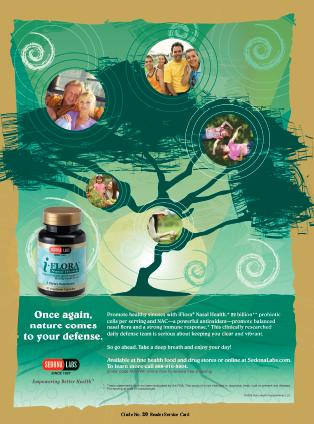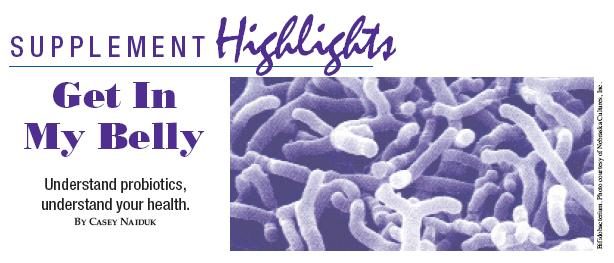Lactobacillus acidophilus. Bifidobacterium lactis. Saccharomyces boulardii. These are the names of good bacteria that make their home in your body. These probiotics, and others, may be just the boost you need to lead a healthier life.
Meet Probiotics
Probiotics are live microorganisms that confer a health benefit on the host (1). What does this mean for your body? Your intestinal tract is swarming with trillions of microorganisms, some of which are detrimental to your health. Illness and disease often arise when the balance of bacteria shifts too heavily in favor of the pathogens (i.e., disease-producing microorganisms).
Probiotics are “friendly,” and work with the body to maintain a healthy balance of bacteria (2). Karen DeFelice, an author on enzymes, behavior and health, explains it in a way everyone can understand. She says, “A consistent supply of probiotics is like tending a lawn. You need to kill the weeds, and then keep seeding with the ‘good’ grasses. A healthy lawn will need just a little maintenance. However, doing no maintenance will very soon give you a yard overrun with weeds again” (3).
Pathogens are opportunistic and jump at any chance to cause an infection. Some factors that contribute to unhealthful bacteria balance and provide a window of opportunity for infection and illness are stress, poor nutrition, lack of exercise, and antibiotic use, overuse and misuse.
Antibiotics target and destroy a wide range of the dangerous organisms that make you sick (4). Though they kill bad bacteria, they also kill many beneficial bacteria that fight for your health in the large intestine, leading to diarrhea. About one in five people interrupt their prescribed course of antibiotics because diarrhea has interrupted them. Complimenting antibiotic therapy with probiotics can stop this by restoring the bacterial balance disrupted by antibiotics and infections (5). 
Combining prebiotics with probiotics gives the good bacteria a better opportunity to grow and flourish. Think of prebiotics as food for probiotics. Prebiotics are non-digestible carbohydrate fibers (mostly oligosaccharides), but as they make their way through the digestive system, they selectively feed probiotics, keeping them healthy and allowing them to multiply faster in the gastrointestinal tract (6). These oligosaccharides are found in fruits, some vegetables, whole grains and legumes (2). Also, yogurts made with bifidobacteria contain oligosaccharides.
Safety First
Probiotics are considered to be safe; however, as with any changes in diet, their use in those who are ill or have a compromised immune system should be monitored. One study reports that infections caused by lactobacilli and bifidobacteria are extremely rare (infection found in 0.05%–0.4% of those taking probiotics) and that most cases of infection occur in severely high-risk patients (7).

How do these microscopic defenders work and always find themselves in position to show off their immunomodulatory and anti-inflammatory properties? The thinking for a long time was that they simply made their home along the walls of our intestines, essentially blocking pathogens from adhering and growing. While it is true that probiotics inhibit pathogens by competing for nutrition and adhesion sites, they don’t stop there. Recent research suggests that probiotics produce infection-fighting substances such as hydrogen peroxide and bacteriocins. They also release cell signals that strengthen mucus barriers against trespassing pathogens, as well as other signals that prevent toxins from being released (8). The secretion of antimicrobial substances and toxin inactivation are all in a day’s work for these tiny heroes.
Differences Among People
Probiotics are safe for people of all ages and can be beneficial for infants, children and adults. Special consideration should be given to the elderly. The elderly have very low counts of bifidobacteria, which corresponds with high levels of toxins (6). Administering probiotics can be especially helpful under such circumstances to destroy pathogenic bacteria; however, weak or high-risk individuals absolutely must be monitored closely.
Infants are also a special group to examine. Studies have shown that the majority of vaginally born babies were colonized with Bifidobacteria infantis, a friendly bacterium. In contrast, a small percentage of babies born by cesarean section carried it. It seems that passage through a clean and healthy birth canal enables these bacteria to rub off onto the child. As the name hints, Bifidobacteria infantis is a natural choice for infants (4). This probiotic is safe and mild for the little ones to take, once approved by a pediatrician.
What Do They Treat?
Digestion. Probiotics’ most substantiated contribution to healthy living may be their effect on diarrhea. Diarrhea can be caused by a number of factors such as antibiotic use, irritable bowel syndrome, traveling or anything that disrupts normal bacteria balance in the digestive system. Because probiotics aid in the digestive process, they have shown the facility to correct other bowel problems, including constipation, cramps, gas and bloating. Although current evidence is not conclusive, there is reason to be hopeful that the anti-inflammatory properties of probiotics may benefit those with inflammatory bowel diseases such as colitis and Crohn’s disease.
Cancer. Cancers can vary and no dietary changes should be made without first consulting a doctor. That being said, do probiotics have the power to help the “C” word? It is a controversial claim, but it may very well be the case, at least in colon cancer. Dr. S.K. Dash, who has worked with probiotics for over 30 years, says, “It is in the area of prevention of one of our most deadly cancers, that of the colon, that probiotics offer stellar benefits…Healthy populations of friendly bacteria play many important roles in our body’s quest to defend itself against malignant disease” (6). Early research has shown some potential of lactobacilli to fight breast and liver cancer as well.
Immunity Booster. Research has held steady that probiotics boost immune function. It’s hard to explain why this is exactly, but it’s harder to explain why you don’t take advantage it! Some research also shows that consumption of probiotics can lower your blood cholesterol level, which would in turn lower your risk for coronary disease.
Clear Skin. Although all the kinks have not yet been worked out, there is evidence in some cases that probiotics help fight allergies that lead to acne and eczema.
But Wait, There’s More. Probiotics may also protect against food poisoning, urinary tract infections, migraines, and rheumatic and arthritic symptoms. As if they don’t do enough already, probiotics also help produce enzymes that are necessary to digest milk and dairy (4). This is significant not only because it enables calcium to give us strong bones and teeth, but it also may also aid in lactose intolerance.
Gimme Some
Probiotics are available in several forms, allowing you to incorporate them into your health in a way that suits your lifestyle. They can be found in food (such as yogurt, acidophilus milk, even some granola bars) or can be taken as pill or powder supplements. For years, yogurt has been known to be a prime and easily accessible source for Lactobacillus acidophilus, one of the heaviest hitting probiotics that is renowned for improving digestion and protecting the heart. Many yogurts are now being enhanced with several other lactobacilli and bifidobacteria.

What To Look For. Different bacteria serve different functions, so it is best to integrate many of them. Lactobacillus casei is used to boost immunity. Lactobacillus rhamnosus is linked to relieving diarrhea and may fight eczema. Bifidobacterium lactis promotes colon health and certain strains boost immune function, especially in older people. Saccharomyces boulardii may combat diarrhea and can often be found as a supplement. Be sure to look for these bacteria, as they are some of the most common probiotics.
There are a few things consumers should be aware of to protect themselves. A piece in the Wall Street Journal highly recommends choosing products that list a specific strain of bacteria. “Look for three names.” A common example is Lactobacillus rhamnosus GG, with “GG” identifying the exact strain. Certain strains are more substantially tested and can be more effective, so neglecting to include the strain may be a tactic to mislead consumers (9). Also, many bacteria—although not all—must be live to be effective, so you may feel more comfortable choosing products that advertise “live” on their labels. WF
References
1. Food and Agriculture Organization, “Guidelines for the Evaluation of Probiotics in Food,” 2002.
2. J.R. Taylor, N.D., et al., The Wonder of Probiotics (St. Martin’s Press, New York, NY, 2007).
3. K. DeFelice, Enzymes for Autism and other Neurological Conditions (ThunderSnow, Johnston, IA, 2002).
4. N. Trenev, Probiotics: Nature’s Internal Healers (Avery Publishing Gr., Garden City Park, NY, 1998).
5. B. Kliger and A. Cohrssen, “Probiotics,” American Family Physician, 78 (9), 1073–1078 (2008).
6. S.K. Dash, Ph.D., A Consumer’s Guide to Probiotics (Freedom Press, Topanga, CA, 2005).
7. S.P. Borriello et al., “Safety of Probiotics That Contain Lactobacilli or Bifidobacteria,” Clin. Infect. Dis. (36) 2003.
8. G. Reid, Ph.D., et al., “Probiotics: Some Evidence of Their Effectiveness.” Canadian Fam. Phys. Nov 10, 2005.
9. L. Johannes, “Bug Crazy: Assessing the Benefits of Probiotics,” Wall St. J., Jan. 13, 2009.
Published in WholeFoods Magazine, April 2009









